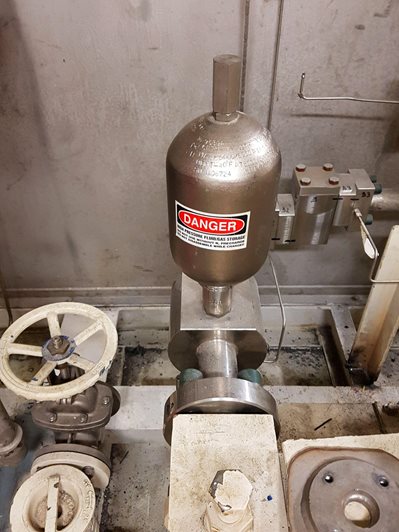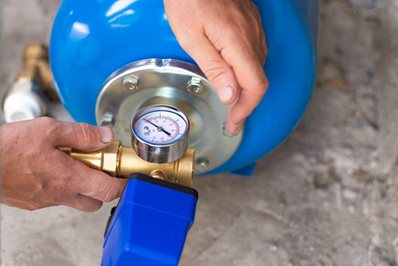What Gas Is Used in Hydraulic Accumulators?
.jpg?width=397&height=265)
Hydraulic accumulators are an essential component of many types of hydraulic systems. Their purpose is to store energy and discharge it when needed to help improve the efficiency of the hydraulic system of which it is a part.
What Is a Hydraulic Accumulator?
A
hydraulic accumulator is a self-contained high-pressure component that is gas-charged, typically with nitrogen on one side and the hydraulic fluid from the circuit to which it is attached on the other. The hydraulic fluid compresses the gas as the circuit pressure rises so the compressed gas is transformed into a store of energy. This may just be used to provide an element of damping or be locked in for release at a later time.
The exterior part of the accumulator can be made from steel, titanium, or other sturdy materials that can withstand the system pressure. The interior of the accumulator contains a piston, bladder, or diaphragm used to compress gas at a precharged pressure for when it is needed.
How Does a Hydraulic Accumulator Work?
For the accumulator to store energy, it begins in a precharged state where the gas volume fills most of the space inside the accumulator. As the fluid pressure Increases the gas is compressed reducing the volume occupied by it.
As the oil fills the chamber, it causes the bladder, piston, or diaphragm to move and fill mostly with hydraulic fluid.
If the accumulator is being used to store hydraulic energy for a later point it will probably have a pilot operated check valve that allows pressurisation of the accumulator but does not release the pressurised fluid until pilot pressure is applied to release it.
When the fluid is released the highly pressurised gas will drive the fluid out until the gas can expand no more either because there is no oil left to push out or it reaches a new equilibrium between gas and fluid pressure.
The process of moving from a precharged state to a charge state continues to cycle until the system is shut down. When the system is shut down, if the accumulator is in a charged state, it will remain charged. Therefore, it is essential to be aware of this before performing hydraulic system maintenance.
What Does a Hydraulic Accumulator Do?
A hydraulic accumulator is designed to provide one of two types of functions. The first function is to add fluid volume to the system at a fast rate when system pressures drop to increase pressure.
The second function is as a damper to absorb circuit shock. When an accumulator is used as a shock absorber it is normally smaller and with a lower precharge pressure than a unit designed to be used as a conventional accumulator.
Types of Hydraulic Accumulators
Bladder Accumulators

A bladder accumulator has a balloon or sack that is filled with nitrogen. As
hydraulic fluid is forced into the accumulator, the bladder and gas inside it are compressed. When an increase in system pressure is needed, the rubber bladder expands, pushing the fluid out of the accumulator.
Bladder accumulators offer some of the highest efficiencies. However, nitrogen gas can leak out, and the bladder needs to be recharged periodically.
Piston Accumulators
In piston accumulators, the nitrogen gas is kept inside a cylinder on one side of the piston. As hydraulic oil is forced into the accumulator, it forces the piston to move into the cylinder housing compressing the gas. When system pressure needs to be increased, the compressed nitrogen pushes the piston in the other direction and forces the hydraulic oil out of the cylinder and back into the system.
One of the primary benefits of piston accumulators is their simplicity but they do incorporate more seals than other types but they can be made more compact than either bladder or diaphragm ones.
Diaphragm Accumulators
Diaphragm accumulators function similarly to bladder accumulators. However, there is an elastic diaphragm in place of the rubber bladder to keep the gas and oil separate. One of the benefits of diaphragm accumulators is they can handle higher fluid pressure rates.
Another benefit of diaphragm accumulators is that they are lightweight and economical, making them well-suited for mobile hydraulics. They also respond quickly when there are changes in pressure and can alternate between increasing system pressure and functioning as a shock absorber.
Diagnosing and Resolving Hydraulic Accumulator Issues

When you notice a loss of system pressure or system efficiency and all other components of the hydraulic system are functioning correctly, chances are the problem is with one or more accumulators as follows:
- Bladder accumulators lose efficiency when there is a loss of gas or the bladder lining is damaged where has leaked through to the gas side. You can attempt to recharge the gas to see if this resolves the issue. If not, then the bladder needs to be replaced.
- Piston accumulators can lose efficiency should the piston seals start to fail causing the gas to leak into the . Replacing the seals will normally fix this problem.
- Diaphragm accumulators can lose efficiency when the elasticity of the diaphragm fails and it tears. When this happens, the gas will leak out and mix with the . The solution, in this case, is to install a new diaphragm accumulator as they are not repairable.
Another component to inspect is the check valve to ensure that it is opening and closing correctly. When a valve fails and does not open or close, then the accumulator will not function either.
How Often Should Accumulators Be Inspected?
Part of your hydraulic system maintenance should include inspecting accumulators at set intervals, typically after a certain number of operating hours. When inspecting them, check for cracks in the external housing, rust, or other damages.
Inspect all hoses, fittings, and valves connected to the accumulator to look for signs of fluid leaks. If you notice any issues, it is essential to resolve them before continuing to use the accumulator.
Most importantly, please remember that accumulators may be charged, so you must release that pressure before servicing them..
Hydraulic Accumulators and System Parts
It is easy to find new hydraulic accumulators, pumps, motors, cylinders, and other hydraulic system parts at
White House Products, Ltd. Please feel free to register on our website or
contact us at +44 (0) 1475 742500 today!
Back to blog posts